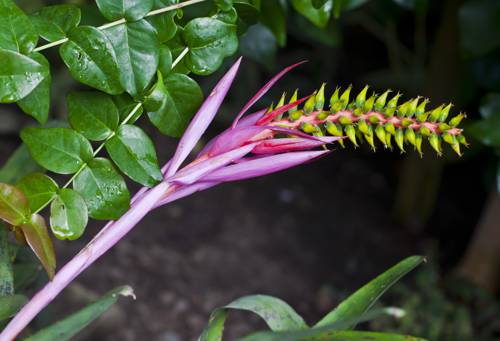
FAQ About Indoor Bromeliad Care

What type of light is best for indoor bromeliads?
Bromeliads thrive in bright, indirect sunlight. Direct sunlight can scorch their leaves, so it's best to place them near a window where they receive plenty of filtered light. If natural light is insufficient, you can use fluorescent light to supplement their lighting needs.

How often should I water my indoor bromeliad?
Bromeliads prefer to be watered sparingly. Water them once a week, allowing the top inch of soil to dry out between waterings. Ensure the central cup of the plant, known as the rosette or tank, stays filled with water, but change it frequently to prevent stagnation.

What is the ideal temperature range for bromeliads indoors?
Bromeliads do best in temperatures between 60°F (15°C) and 80°F (27°C). They cannot tolerate freezing temperatures, so it's important to keep them in a warm environment, especially during winter months.

Do bromeliads require special soil for indoor growth?
Bromeliads need well-draining soil to prevent root rot. A mix of orchid potting mix with a bit of sand or perlite works well. This provides the aeration and drainage they require.

How do I fertilize my indoor bromeliad?
Fertilize bromeliads sparingly during their growing season, which is spring through summer. Use a half-strength balanced liquid fertilizer every month. Avoid over-fertilization as it can harm the plant.

Can I grow bromeliads indoors all year round?
Yes, bromeliads are well-suited for indoor growth year-round, provided they receive adequate light, warmth, and humidity. They make excellent indoor plants, adding vibrant color and unique textures to your home.

What humidity level is suitable for indoor bromeliads?
Bromeliads appreciate high humidity levels, ideally above 50%. If your home is dry, especially during winter, consider using a humidifier or placing a tray of water near the plant to increase humidity.

How can I propagate indoor bromeliads?
Bromeliads can be propagated through pups, which are small offshoots that grow from the base of the parent plant. Once a pup is about one-third the size of the parent, you can separate and plant it in its own container.

Why are the leaves of my bromeliad turning brown?
Brown leaves can be a result of underwatering, too much direct sunlight, or low humidity. Ensure the plant is adequately watered, receives indirect light, and is kept in an environment with sufficient humidity.

What pests should I watch out for in indoor bromeliads?
Common pests include mealybugs, aphids, and scale insects. Regularly inspect the plant for pests, and treat infestations with insecticidal soap or neem oil.

Can I keep bromeliads in low-light conditions?
While bromeliads can survive in low-light conditions, they may not thrive and could lose their vibrant colors. To maintain their health, place them in areas with bright, indirect sunlight or supplement with artificial lighting.

Are bromeliads toxic to pets?
Bromeliads are non-toxic to pets, making them a safe choice for households with animals. However, it's still advisable to keep them out of reach as ingestion of plant material can sometimes cause mild discomfort.

How do I encourage my bromeliad to flower?
Bromeliads flower once in their lifetime and then focus on producing pups. To encourage flowering, ensure the plant has optimal lighting, watering, and temperature conditions. Ethylene gas can stimulate flowering; place a ripe apple near the plant for a few days.

What are the signs of over-watering a bromeliad?
Over-watering bromeliads can lead to root rot, which is indicated by soft, mushy leaves and a foul odor from the soil. Ensure adequate drainage and allow the soil to dry between waterings.

Do bromeliads need pruning?
Pruning is generally unnecessary for bromeliads. Remove dead or brown leaves by cutting them off close to the base to maintain the plant's appearance, but avoid extensive pruning as it can harm the plant.

Can I keep bromeliads in the bathroom?
Bathrooms can be ideal locations for bromeliads as they naturally have higher humidity levels, which benefit the plants. Ensure they receive some light, ideally through a window or with artificial lighting.

How long do bromeliads live indoors?
Bromeliads can live for several years indoors. Although each plant flowers only once, they produce offsets, or pups, which can be grown into new plants, ensuring the continuation of the bromeliad line.

Do bromeliads attract insects indoors?
While not especially prone to insect issues, the central cup of a bromeliad can attract mosquitoes if water is left stagnant. Regularly refresh the water and ensure proper drainage to minimize this risk.

How do I repot a bromeliad?
Repot bromeliads when pups outgrow their container. Handle the plant carefully, remove the old potting mix, and transfer it to a slightly larger container with fresh, well-draining soil. Avoid deep planting; bromeliads don't need to be buried deep into the soil.

Are bromeliads suitable for beginners?
Bromeliads are excellent for beginners due to their low maintenance requirements and tolerance of varying conditions. Their unique appearance and vibrant colors make them a rewarding choice for novice indoor gardeners.
